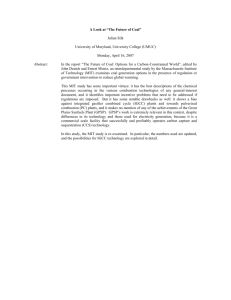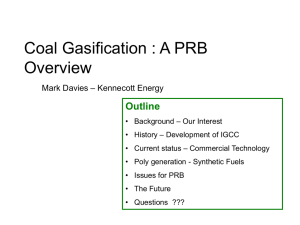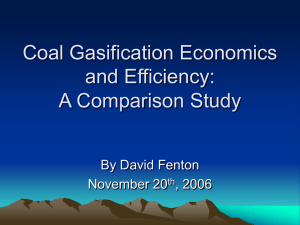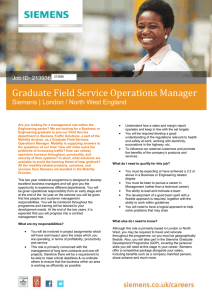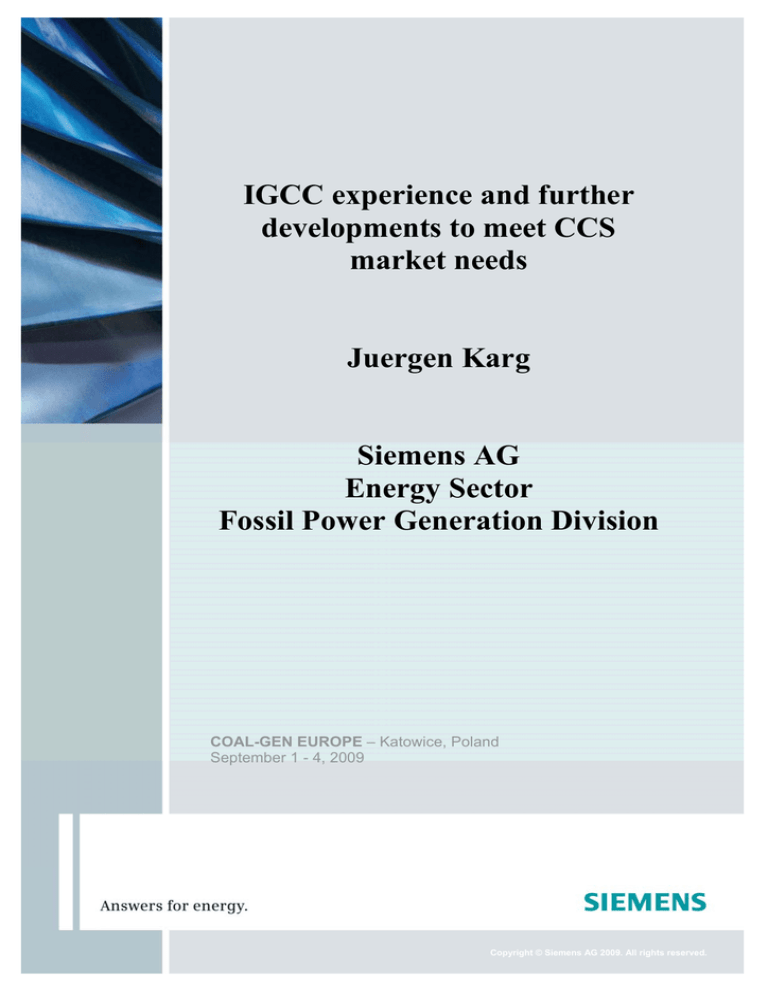
IGCC experience and further
developments to meet CCS
market needs
Juergen Karg
Siemens AG
Energy Sector
Fossil Power Generation Division
COAL-GEN EUROPE – Katowice, Poland
September 1 - 4, 2009
1
Copyright © Siemens AG 2009. All rights reserved.
Copyright © Siemens AG 2009. All rights reserved.
Abstract ..................................................................................................................... 3
Market requirements and CCS options................................................................... 4
Market environment .............................................................................................. 4
CCS options .......................................................................................................... 5
Available experience with IGCC .............................................................................. 7
Key components and integration............................................................................ 8
Integration ............................................................................................................. 8
Gas Turbine ......................................................................................................... 10
Gasification ......................................................................................................... 15
Challenges for IGCC commercialization, improvement potential ...................... 17
Summary, conclusions .......................................................................................... 19
Copyright © Siemens AG 2009. All rights reserved.
2
Abstract
The knowledge about current market requirements is the decision basis for further
development and improvements of products in the energy sector. An important
requirement is to meet the world’s growing need for energy which demands for clean
and efficient solutions in power generation, transmission and distribution.
Coal is readily available all over the world and has risen only moderately in price
compared with gas. As a result, coal-fired power plants are a fundamental element of
the world’s energy supply. Accordingly, technologies have to be employed to lower
the carbon dioxide emissions of these plants.
Two promising methods for the capture of carbon dioxide are post-combustion and
pre-combustion technologies. Siemens is developing solutions for both technology
paths. This paper will focus on pre-combustion capture, i.e. IGCC.
The identified market requirements and the available broad operational experience
from existing IGCC plants form the basis for the further IGCC development. This
includes the results of recent studies and the analysis of lessons learned for future
robust plant designs.
An update on key IGCC components is given, covering gas turbine and gasification.
However a special focus will be on system integration aspects and their relevance to
current market requirements. Examples are (air/nitrogen) integration alternatives for
the air separation unit (ASU) or the gasifier concept.
The view on customer requirements on one hand and technology development on
the other hand has to be combined with an evaluation of the challenges for IGCC
commercialization under the current market conditions.
Copyright © Siemens AG 2009. All rights reserved.
3
Market requirements and CCS options
Market environment
By approximations of the UN, the world’s population will grow by 1.1 billion to reach
7.5 billion people by 2020. This growth will be accompanied by a trend towards
further growth and industrialization of transitional countries. In combination with an
additional increase in urbanization, this will lead to a rapidly increasing demand for
energy.
Electrical power is the primary most suitable energy carrier that can meet the
challenges of the future. The highest efficiencies in generation and utilization, as well
as the inclusion of renewable sources, represent indispensable advantages in the
struggle against climate change. While fossil fuels, and especially coal, will continue
to play a central role in power generation, the future, more than ever, calls for a
diversified energy mix. Therefore, more efficient use of fossil fuels has to be
combined with an intensified reliance on renewable energy sources (Fig. 1).
Fig. 1: Renewables are gaining in importance – fossil fuels will continue to be the mainstay
Copyright © Siemens AG 2009. All rights reserved.
4
Fig. 2: From primary energy to power distribution – CO2 reduction in the whole process chain
In general the necessity for more efficient use of primary energies in combination
with more stringent environmental regulations for fossil-fuelled power plants will push
concepts with increased efficiencies and reduced CO2 emissions. This is valid for the
whole process chain starting with primary energy and ending with power distribution
to the consumers (Fig. 2).
Against this background development of new and improved technologies for future
applications is a permanent challenge. Among these technologies there are highly
efficient gas turbines for CCPP or IGCC applications and the supercritical steam
technology for power generation. Further innovations include highly efficient
transformers as well as ultra-high-power transmission and gas-insulated
underground power lines for low-loss transmission of vast power quantities into
metropolitan areas.
CCS options
As far as the power generation part is concerned, increasing efficiencies is one of the
levers for reduction of CO2 emissions. Especially for coal as a fuel with high carbon
content also solutions with CCS (Carbon Capture Sequestration) have to be
considered to make coal-fired power plants carbon-neutral and to achieve the CO2
emission reduction targets (Fig. 3).
Copyright © Siemens AG 2009. All rights reserved.
5
Integrated Gasification Combined Cycle (IGCC) technology with CCS is one of the
promising options which need to be considered for future power generation. These
future IGCC applications with CCS can take advantage from the experience and
lessons learned from IGCC plants without CCS as they are in operation e.g. in
Buggenum/The Netherlands or in Puertollano/Spain.
In addition to the experience with IGCC plants on a large-scale there is also
significant experience available with CO2 capture from syngases in the chemical
industry. According to information from the Gasification Technologies Council more
than 80 percent of the global industrial gasification capacity is already capturing CO2
as part of the manufacturing process, but not for sequestration.
Fig. 3: Process options for CO2 capture
Copyright © Siemens AG 2009. All rights reserved.
6
The second option toward carbon-free, fossil-based power generation pursued by
Siemens is the post-combustion capture technology (Fig. 4).
Fig. 4: Siemens preferred solutions for CO2 capture
Available experience with IGCC
The development and demonstration efforts related with Integrated Gasification
Combined Cycle technology were originally focussed on improved concepts for coalbased plants and thus on an alternative to conventional steam plants. The
experience with the demonstration plants in Europe, in the United States, and now
also in Japan, and the parallel development efforts for improved steam power plants
resulted in a situation where coal-based IGCC is on the one hand today to be
considered as a commercially available technology which on the other hand still
needs further improvement of economics to be fully competitive.
Next generation plants of larger size, where the lessons learned from the operational
plants are implemented and co-firing of low-cost fuels, wastes or biomass is foreseen
for reduction of fuel costs and/or to produce green electricity, could pave the way for
a commercial breakthrough. This is primarily expected for IGCC applications with
CCS.
Copyright © Siemens AG 2009. All rights reserved.
7
Total
MWel
Total
Operational
Operational Oil/
Operational
Coal/petcoke
heavy residues
MWel
IGCC
IGCC
Europe
4,170
2,620
35 %
65 %
Asia/Australia
1,400
1,120
29 %
71 %
2,020
960
83 %
17 %
7,590
4,700
43 %
57 %
Americas
USA, Canada
Total
Table 1: IGCC power plants built, in operation, under design, construction or commissioning
The situation is different for refinery residues where, depending on the individual site
conditions, IGCC can already today be considered as a commercially attractive
solution for power generation, co-generation or co-production of power and hydrogen
for refinery-internal purposes. The introduction of IGCC for refinery applications was
supported by the experience gained with the technology from the coal-based plants.
From the 7,600 MW of global IGCC power plants which have been built, or are under
design, construction and commissioning, 4,700 MW are in operation. About 55 % of
this operational capacity is installed in Europe (Table 1).
Key components and integration
Integration
IGCC power plants are not simply combined cycle power plants (CCPP) where the
standard pipeline fuel natural gas is replaced by syngas. When integrating a
gasification plant and a gas island, respectively, with a CCPP, several specific
aspects have to be considered. The most important one is related with the gas
turbine and the application of syngases with moderate or, in case of plant concepts
with CCS, high hydrogen content, which must be handled by the combustion system.
Copyright © Siemens AG 2009. All rights reserved.
8
The gas turbine is also affected by the optional interaction with the air separation unit
(ASU). This is valid for the supply of dilution nitrogen from the ASU for NOx and
reactivity control, but also with regard to an optional (limited) process air supply from
the gas turbine compressor for the ASU.
On the other hand also the sensible heat from the different process steps in the gas
island needs to be properly integrated with the water/steam cycle of the CCPP unit
and the overall IGCC, respectively.
The coal-based IGCC power plants which have been built in Europe were designed
targeting maximum overall net plant efficiency under the given fuel and site
conditions with the gas turbine technology available at the time of decision-making.
This resulted in the selection of plant concepts will full air-side and nitrogen-side
integration between gas turbine and ASU. The experience has shown that this type
of plants can be operated successfully. On the other hand the lessons learned from
plant operation indicate that reduced integration and the availability of a separate air
compressor, which can at least cover the needs of an independent ASU start-up, can
contribute to increased operational flexibility and robustness. As a consequence plant
concepts with no or only partial air-side integration are preferred for future new IGCC
plants without and with CCS (Fig. 5).
Fig. 5: Integration options for IGCC power plants
Copyright © Siemens AG 2009. All rights reserved.
9
Considering on one hand operational flexibility and robustness as a must for new
IGCC power plants and on the other hand the need for high efficiencies, special
attention has to be given to an optimised integration. Plant concepts with full nitrogen
integration but no or only partial air-integration typically result in reduced overall net
efficiencies compared with a fully air and nitrogen integrated concept. Against this
background modified concepts have to be implemented which can at least partly
compensate the losses at lower air integration. One contribution to the performance
improvement can come out of a combination of reduced nitrogen integration and
optimised saturation of the syngas using preferably low-temperature level heat from
the overall process (Fig. 6).
Fig. 6: Effect of ASU integration on net IGCC plant efficiency
Gas Turbine
For achieving high efficiencies with CCPP and IGCC power plants the gas turbine
plays a major role. The Siemens heavy-duty gas turbine portfolio is designed to
support high CCPP efficiencies. The most advanced engine, which is the new SGT58000H, is designed to achieve more than 60 % efficiency in combined cycle mode
(Fig. 7 and Fig. 8).
Copyright © Siemens AG 2009. All rights reserved.
10
Fig. 7: Siemens heavy-duty gas turbine portfolio
Fig. 8: Evolution of Siemens combined cycle efficiency
Continuous development efforts have contributed to significantly increase CCPP
efficiencies over the last two decades up to the high level achievable today, which
also contributes to a significant reduction of CO2 emissions (Fig. 8). In parallel to the
improvements implemented for natural gas-based gas turbines, developments were
made to enable syngas as a fuel and thus integration of gas turbines in IGCC plants.
Copyright © Siemens AG 2009. All rights reserved.
11
As a consequence Siemens has been involved in all of the European coal-based
IGCC demonstration plants, including the world’s first IGCC built in Germany. All of
these European demonstration plants included the largest syngas-capable 50-Hz gas
turbines available at the time of decision-making for these projects. Compared with
other coal-based IGCC plants built in the 1980ies and 1990ies in the United States,
and also after 2000 in Japan, the European plants achieved significantly higher
efficiencies as a result of the selected technologies and the gas and water/steamside integration philosophy (Fig. 9).
Fig. 9: Development of IGCC net plant efficiencies for coal-based plants without CCS
Today, broad experience is available within Siemens which covers a wide range of
IGCC application alternatives (Table 2) concerning plant integration, gasifier fuels
and resulting syngas compositions. Currently, the total syngas/ IGCC experience
sums up to more than 650,000 operating hours, including steel-mill recovery gas
applications.
Copyright © Siemens AG 2009. All rights reserved.
12
Customer/Plant
(Location)
Hörde Steelworks
(Dortmund, Germany)
Handan Iron & Steel
(Handan, P.R. China)
U. S. Steel Corp.
(Chicago, USA)
STEAG/Kellermann
(Lünen,Germany)
DOW Chemicals
(Plaquemine, USA)
Nuon Power Buggenum
(Buggenum,
Netherlands)
HRL
(Morwell, Australia)
Sydkraft
(Värnamo, Sweden)
ELCOGAS
(Puertollano, Spain)
Electrical
Output
(net)
Gas
Turbine
8 MW
1x
VM5
20 MW
1 x V93
208 MW 1)
2x
W501D5
253 MW
1x
V94.2
6 MW
300 MW
Blast-furnace-gas-fired, gas turbine as
compressor drive
1 x CW201 Blast-furnace-gas-fired gas turbine
163 MW
10 MW
Main Features
1x
Typhoon
1x
Typhoon
1x
V94.3
Startup
1960/
2000
1960
First CC plant in the world with integrated
1972
LURGI coal gasification (hard coal)
CC plant with integrated DOW coal
1987
gasification
CC plant with integrated SHELL coal
1993 2)
gasification (hard coal and biomass
1994/
blend)
95
CC plant with integrated drying
1996
gasification process (lignite)
First CC plant in the world with integrated
1996
biomass gasification
CC plant with integrated PRENFLO coal 1996 2)
gasification (coal and petroleum coke
1997/
blend)
98
CC plant with integrated TEXACO heavy- 1998 3)
oil gasification (asphalt)
1999
ISAB Energy
2x
521 MW
(Priolo Gargallo, Italy)
V94.2K
ELETTRA GLT
1x
180 MW
CC plant with steel-making recovery gas
(Servola, Italy)
V94.2K
ARBRE
1x
CC plant with integrated biomass
8 MW
(Eggborough, UK)
Typhoon gasification
EniPower
CC plant fuelled with syngas from SHELL
250 MW 1 x V94.2K
(Sannazzaro, Italy)
heavy-oil gasification
Huaneng Tianjin IGCC
1x
CC plant with integrated TPRI
Green Coal Power
250 MW
SGT5gasification (coal)
(Tianjin, China)
2000E(LC)
1)160 MW from syngas and 48 MW from natural gas; 2) Natural gas firing; 3) Oil firing;
SGT5-2000E = V94.2 (old naming);
SGT5-2000E(LC) = V94.2K (old naming) => engine with modified compressor
2000
2002
2006
2011
Table 2: Syngas/IGCC experience
Siemens participated in the 1990ies in both of the European coal-based IGCC
demonstration plants which are today running as commercial plants with
coal/biomass (Buggenum) or coal/petroleum coke mixtures (Puertollano). Presently,
there are activities underway to install at both plants, Buggenum and Puertollano,
small-scale demonstration facilities for separation of CO2 from syngas.
Siemens was already involved in world's first IGCC plant which was started up in
1972 at Steag's Lünen site in Germany. In 1987 a further plant was started up at
Plaquemine in the United States where syngas from coal gasification was used in
gas turbines.
Based on the experience gained from the large coal-based IGCC applications in
Europe and in the United States IGCC technology was then also selected for clean
Copyright © Siemens AG 2009. All rights reserved.
13
use of refinery residues. Several such commercial plants are running today in Italy,
and the plant at Priolo Gargallo has two gas turbines with Siemens technology which
are operated successfully since the end of the 1990ies. A further residues-based
plant is in operation at Sannazzaro. The latest syngas reference is a gas turbine
application within a coal-based IGCC plant at Tianjin which is part of China’s
GreenGen Programme.
Based on the experience from the operational plants, syngas solutions for already
syngas-proven and commercially offered 50-Hz E class gas turbines have been
further improved. The syngas-capable F class gas turbine for 50-Hz markets is under
development and ready for bid in short term. For this engine the special focus is on
CCS applications and syngas fuels with high hydrogen content. E and F class gas
turbines for syngas applications in 50-Hz markets are specifically designed to meet
the requirements of IGCC plant concepts without or with only limited air integration
with the ASU. As a consequence both engines, designed for low calorific fuels, have
one additional compressor stage (Fig. 10).
A modular syngas fuel conditioning and optional air extraction system enables
conditioning of the syngas with nitrogen and water vapor according to the emission
reduction and reactivity control requirements of the gas turbines. The modular fuel
system is also integral part of the overall plant performance optimization efforts.
Fig. 10: 50-Hz gas turbine modifications for IGCC application
Copyright © Siemens AG 2009. All rights reserved.
14
Gasification
For IGCC applications another key component is the gasification technology.
Oxygen-blown entrained–flow gasification technology with dry fuel feeding has been
demonstrated to be the most suitable and fuel-flexible solution for IGCC applications,
resulting in higher overall plant efficiencies compared with other gasification
principles. The Siemens Fuel Gasification (SFG) technology is of this type.
The SFG technology is applicable for a wide range of feedstocks. Especially
depending on the fuel ash content either a reactor with cooling screen or with
refractory lining is available (Fig. 11). The latter is also applicable for liquid feedstock
as for example refinery residues.
Siemens has acquired the gasification technology in 2006. Since that time significant
successes have been achieved for introduction of commercial-size gasifiers to the
market. Present focus is on applications in the chemical industry, but the technology
has also been selected for IGCC projects (Table 3).
For coals typically the reactor with cooling screen and pneumatic dense flow feeding
system is the preferred and robust design, resulting in high conversion efficiencies. In
combination with a downstream water quench instead of a syngas cooler this system
is also an ideal fit for CCS solutions where steam is required for the conversion
reaction in the CO-shift.
For IGCC applications without CCS a syngas cooler downstream of the gasifier is
beneficial for improved heat recovery to produce for example high pressure steam
which can be integrated effectively with the water/steam process of the CCPP and
thus increases overall plant efficiency significantly. All of the existing coal-based
IGCC power plants are based on gasifiers with syngas coolers for this purpose.
For IGCC plants with CCS the situation is different as a – at least partial – water
quench has advantages in conjunction with the CO-shift which is needed in this case
as a pre-condition for the CO2 removal. As a consequence the advantage in
efficiency of a syngas cooler concept compared with a full water quench becomes
smaller (Fig. 12). Against this background solutions are under investigation, which
Copyright © Siemens AG 2009. All rights reserved.
15
enable an optimized and economic heat recovery considering the specific
requirements of applications with CCS.
Cooling Screen
Gasifier
Gasification conditions and reactor type
depend on feedstock characteristics:
Ash content & Physical characteristics
Refractory Lined
Gasifier
Burner insert
Cooling wall
Refractory
lining
Carbon, hydrogen content, heating value,
moisture level
Cooling water
Cooled
reactor outlet
Ash composition determines ash melting
temperature
Gasification temperature
AMT: 1,300 - 1,800 °C (2,370 - 3,270 F)
Ash content: > 2 %
Reactor wall with
cooling screen
Slag layer for
thermal protection
Feedstock: Solid
Feedstock: Liquid
Pneumatic dense
flow feeding
system
Feed pumping
Ash content: < 2 %
Reactor wall with
refractory lining
Liquid spray
burner
Dust fuel burner
Fig. 11: Gasification product design for different feedstocks
Fig. 12: Influence of gasifier syngas heat recovery concept on IGCC net efficiency
Copyright © Siemens AG 2009. All rights reserved.
16
Table 3: Siemens gasification experience and current projects
Challenges for IGCC commercialization, improvement potential
IGCC has today reached a status where experience is available from 1st generation
and 2nd generation plants, built in the 1970ies/1980ies and in the 1990ies,
respectively. These plants have been built as commercial-scale demonstrators for
coal-based applications. Lessons learned from these plants will help to technically
and commercially improve the next generation.
Today, further developed steam power plant technology is still the benchmark for
gasification-based power plants. As IGCC is still to be considered as a relatively
young technology with limited number of more or less tailor-made plants, it has
significant improvement potential by implementation of the lessons learned for a
more robust plant design, and by standardization.
As for every new technology the most important step for market introduction is to
bridge the gap between funded large-scale demonstration units and fully commercial
applications. This requires market pull instead of product and technology push. For
IGCC applications with CCS, government policies and incentives, as they are for
example intended within the EU Flagship Programme, could first create a niche
Copyright © Siemens AG 2009. All rights reserved.
17
market for supported commercial projects. If these projects can be successfully
implemented, this could pave the way for a commercial breakthrough of the
technology (Fig. 13).
Fig. 13: Actions needed for technology commercialization
Copyright © Siemens AG 2009. All rights reserved.
18
Summary, conclusions
IGCC can be considered today as a technology which is available on a commercial
scale. Further reduction of specific investment costs is required to improve
commercial attractiveness and competitiveness with other power generation
technologies.
IGCC with CCS is a promising technology to satisfy the market needs in a carbonconstrained environment, but a robust regulatory framework and clear investment
incentives are required for a full commercialization.
Siemens has contributed significantly to the development of IGCC technology over
the last decades and has gained experience back from the operational plants for the
key components. This experience is used for further continuous improvement and
development activities related with gas turbines for syngas/hydrogen-rich fuels,
gasifiers and overall plant integration aspects.
Copyright © Siemens AG 2009. All rights reserved.
19
Permission for use
The content of this paper is copyrighted by Siemens and is licensed to PennWell for
publication and distribution only. Any inquiries regarding permission to use the
content of this paper, in whole or in part, for any purpose must be addressed to
Siemens directly.
Disclaimer
These documents contain forward-looking statements and information – that is,
statements related to future, not past, events. These statements may be identified
either orally or in writing by words as “expects”, “anticipates”, “intends”, “plans”,
“believes”, “seeks”, “estimates”, “will” or words of similar meaning. Such statements
are based on our current expectations and certain assumptions, and are, therefore,
subject to certain risks and uncertainties. A variety of factors, many of which are
beyond Siemens’ control, affect its operations, performance, business strategy and
results and could cause the actual results, performance or achievements of Siemens
worldwide to be materially different from any future results, performance or
achievements that may be expressed or implied by such forward-looking statements.
For us, particular uncertainties arise, among others, from changes in general
economic and business conditions, changes in currency exchange rates and interest
rates, introduction of competing products or technologies by other companies, lack of
acceptance of new products or services by customers targeted by Siemens
worldwide, changes in business strategy and various other factors. More detailed
information about certain of these factors is contained in Siemens’ filings with the
SEC, which are available on the Siemens website, www.siemens.com and on the
SEC’s website, www.sec.gov. Should one or more of these risks or uncertainties
materialize, or should underlying assumptions prove incorrect, actual results may
vary materially from those described in the relevant forward-looking statement as
anticipated, believed, estimated, expected, intended, planned or projected. Siemens
does not intend or assume any obligation to update or revise these forward-looking
statements in light of developments which differ from those anticipated.
Trademarks mentioned in these documents are the property of Siemens AG, its
affiliates or their respective owners.
Copyright © Siemens AG 2009. All rights reserved.
20

